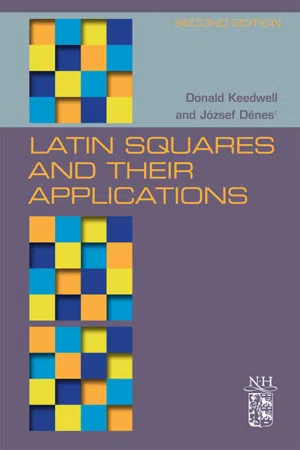
Latin Squares and Their Applications
Latin Squares and Their Applications
- 455 pages
- English
- ePUB (mobile friendly)
- Available on iOS & Android
Latin Squares and Their Applications
Latin Squares and Their Applications
About this book
Latin Squares and Their Applications, Second edition offers a long-awaited update and reissue of this seminal account of the subject. The revision retains foundational, original material from the frequently-cited 1974 volume but is completely updated throughout. As with the earlier version, the author hopes to take the reader 'from the beginnings of the subject to the frontiers of research'. By omitting a few topics which are no longer of current interest, the book expands upon active and emerging areas. Also, the present state of knowledge regarding the 73 then-unsolved problems given at the end of the first edition is discussed and commented upon. In addition, a number of new unsolved problems are proposed.Using an engaging narrative style, this book provides thorough coverage of most parts of the subject, one of the oldest of all discrete mathematical structures and still one of the most relevant. However, in consequence of the huge expansion of the subject in the past 40 years, some topics have had to be omitted in order to keep the book of a reasonable length.Latin squares, or sets of mutually orthogonal latin squares (MOLS), encode the incidence structure of finite geometries; they prescribe the order in which to apply the different treatments in designing an experiment in order to permit effective statistical analysis of the results; they produce optimal density error-correcting codes; they encapsulate the structure of finite groups and of more general algebraic objects known as quasigroups.As regards more recreational aspects of the subject, latin squares provide the most effective and efficient designs for many kinds of games tournaments and they are the templates for Sudoku puzzles. Also, they provide a number of ways of constructing magic squares, both simple magic squares and also ones with additional properties.- Retains the organization and updated foundational material from the original edition- Explores current and emerging research topics- Includes the original 73 'Unsolved Problems' with the current state of knowledge regarding them, as well as new Unsolved Problems for further study
Frequently asked questions
- Essential is ideal for learners and professionals who enjoy exploring a wide range of subjects. Access the Essential Library with 800,000+ trusted titles and best-sellers across business, personal growth, and the humanities. Includes unlimited reading time and Standard Read Aloud voice.
- Complete: Perfect for advanced learners and researchers needing full, unrestricted access. Unlock 1.4M+ books across hundreds of subjects, including academic and specialized titles. The Complete Plan also includes advanced features like Premium Read Aloud and Research Assistant.
Please note we cannot support devices running on iOS 13 and Android 7 or earlier. Learn more about using the app.
Information
Table of contents
- Cover image
- Title page
- Table of Contents
- Copyright
- Foreword to the First Edition
- Preface to the First Edition
- Acknowledgements (First Edition)
- Preface to the Second Edition
- Chapter 1: Elementary properties
- Chapter 2: Special types of latin square
- Chapter 3: Partial latin squares and partial transversals
- Chapter 4: Classification and enumeration of latin squares and latin rectangles
- Chapter 5: The concept of orthogonality
- Chapter 6: Connections between latin squares and magic squares
- Chapter 7: Constructions of orthogonal latin squares which involve rearrangement of rows and columns
- Chapter 8: Connections with geometry and graph theory
- Chapter 9: Latin squares with particular properties
- Chapter 10: Alternative versions of orthogonality
- Chapter 11: Miscellaneous topics
- Comment on the Problems
- New Problems
- Bibliography
- Index